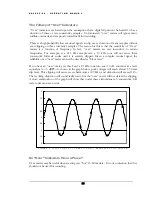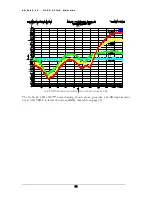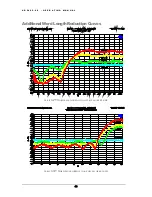
A D 2 4 0 2 - 9 6 - O P E R A T I N G M A N U A L
NS1™ should be reserved for noisy recording environments. The greatest possible dynamic
range will be achieved when the proper function is selected.
The choice of NN™ versus NS™ is mostly a matter of preference while the choice of
curves 1, 2 or 3 is largely dependent upon the dynamic range of the source material. Here are
a few general guidelines that should be followed:
1. If very high playback levels are anticipated, (i.e. playback gain will be high enough for the
noise floor to be heard), use the NN™ settings as these produce natural sounding noise
floors.
2. If the source material has been subjected to a prior 16-bit word length reduction process,
select NN3™ for subsequent processing.
3. If low to moderately high playback levels are anticipated (i.e. playback gain will be low
enough that the noise floor is inaudible), use the NS™ settings as these yield the greatest
dynamic range.
4. The NS™ functions can achieve lower psycho-acoustic noise levels than the
corresponding NN™ functions.
5. When in doubt concerning ambient noise levels, use a higher numbered function.
6. When in doubt concerning anticipated playback levels, use an NN™ function.
7. When totally in doubt, use NN3™ and then try other settings as you gain familiarity with
the system.
8. The mathematically inclined can use the charts in appendix 1 to calculate dynamic range,
and the audibility of the various NN™ and NS™ functions.
While each of the Benchmark NN™ and NS™ processes have been optimized for certain
levels of ambient noise contribution, it is important to point out that the processes do not
rely on this noise for dithering. TPDF dither is always applied to the 24-bit signal prior to
word length reduction. The NN™ and NS™ processes are always fully dithered to insure
full randomization of the quantization noise, and to insure that the quantization noise is de-
correlated from the audio signal. Any of the NN™ and NS™ processes can be used on any
source without the risk of distortion that can result from an inadequate dither process.
Furthermore, the NN™ and NS™ processes can be used in cascade without any ill effects
other than a slight increase in the noise floor.
What Happens when NN™ or NS™ Processes are used in Cascade?
Every time the number of generations is doubled, the noise-floor will increase by 3 dB. For
example, two passes through a NN™ or NS™ process will reduce the dynamic range by 3
dB (as compared to the results obtained after only one pass). After 4 passes through a
NN™ or NS™ process, the dynamic range will have decreased by an additional 3 dB for a
total of 6 dB. And after the 8
th
pass, the dynamic range will have decreased by a total of 9
dB. We have provided charts in appendix 1, which show the results of cascaded processes.
Please note that the noise of a first generation 16-bit process is at or slightly above the
threshold of audibility. Multiple passes through 16-bit word length reduction processes will
raise the noise floor above the threshold of audibility, and should therefore be avoided when
possible. If there is no alternative, and 16-bit word length reduction must be cascaded,
36













































